|
Related FAQs: Damsels, Damsels
2, Damsel
Identification, Damsel
Systems, Damsel Selection,
Damsel Compatibility, Damsel Behavior, Damsel Systems, Damsel Feeding, Damsel Disease, Damsel Disease 2, Damsel Reproduction,
Related Articles: Damselfish, Clownfishes, Abudefduf, Amblyglyphidodon, Chromis, Chrysiptera, Dascyllus. Dischistodus, Giant Damsels, Garibaldi, Microspathodon, Neoglyphidodon, Neopomacentrus, Plectroglyphidodon, Pomacentrus, Stegastes,
Regional Accounts: Clownfishes of Indonesia,
/Fishwatcher's Guide
Series
Indonesian
Damselfishes, Family
Pomacentridae (Sans
Clownfishes)
|
|
| Bob Fenner |
|
Genus Abudefduf:
| Abudefduf septemfasciatus (Cuvier 1830), the
Banded Sergeant. Indo-Pacific in surge zones. To nine inches long
in the wild. Only occasionally imported for our interests. This one
in the Seychelles, Indian Ocean. |
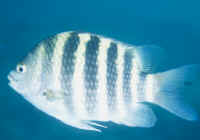
|
| Abudefduf sexfasciatus (Lacepede 1801), the
Scissor-Tail Sergeant. Found all over the Indo-Pacific, but not
Hawai'i. Not as hardy in captivity as other Abudefduf species.
To five inches long. Fiji and N. Sulawesi pix. |
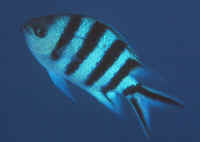 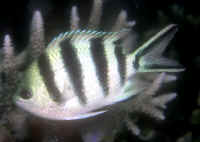
|
| Abudefduf sordidus (Forsskal 1775), The
Black-Spot Sergeant or Dirty Damsel. Indo-Pacific, including
Hawai'i. Lives in high surge areas. To almost seven inches in
length. Only occasionally imported as a pet-fish. These images from
the Maldives and Hawai'i. |
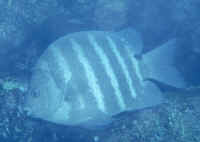 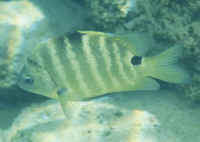
|
| Abudefduf vaigiensis (Quoy & Gaimard
1825), the Indo-Pacific Sergeant Major. Eastern coast of Africa and
Red Sea, out to the Line and Tuamotu Islands. To six inches long.
Fourth black body bar originates after hard dorsal fin. Here in the
Red Sea and Northern Sulawesi. |
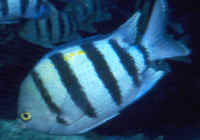 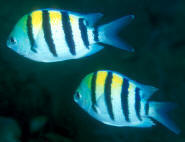
|
Genus Acanthochromis:
| Acanthochromis polyacanthus (Bleeker 1855),
the Spiny Chromis (only member of the genus). Indo-Australian;
inshore and off-shore reefs. Notably the only species of
Pomacentrid that instead of having pelagic larval development,
spawns, rears its young cichlid-fashion. Australian images of a
parent and young. |
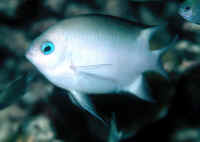 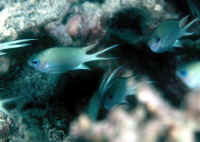
|
Genus Amblypomacentrus:
| Amblypomacentrus breviceps (Schlegel &
Muller 1839), the Black-Banded Demoseille. Indo-Australian
Archipelago; Indonesia, Malaysia, Philippines, Australia, Solomons.
To 5.5 cm. Found on sand, silt bottoms in association with sponges,
small patches of cnidarian life. N. Sulawesi pic. |
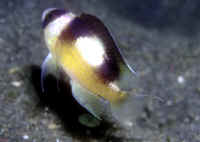
|
Genus Amblyglyphidodon
| Amblyglyphidodon aureus
(Cuvier 1830), the Golden Damselfish. This gorgeous
yellow-gold damsel is found throughout the Indo-West Pacific, the
Andaman Sea, eastern Indian Ocean to Fiji, throughout Micronesia.
The Golden Damsel is mostly found in settings of vertical reef
walls amongst corals and gorgonians. The species feeds almost
exclusively on zooplankton. A juvenile and adult in Bunaken,
Sulawesi, Indonesia, the latter a more mature, less golden specimen
and one off of Pulau Redang, Malaysia. |
|
Amblyglyphidodon batunai Allen, 1995.
|
No pic
|
|
Amblyglyphidodon curacao (Bloch 1787),
the Staghorn Damselfish. From a distance the Staghorn
Damsel looks like a gussied-up Sergeant Major (Abudefduf)
species'¦ with more yellow surrounding its vertical body
bars, greater reflectance and a taller/thinner, more stately
overall shape and demeanor. This species distribution masks much
of the Golden congeners'¦ widely spread in the Indo-West
Pacific, Malaysia to Japan, south to Australia's GBR, and
throughout Micronesia. The Staghorn Damsel is found in lagoons to
outer reefs, often amongst soft and Acroporid (Staghorn) corals,
feeding on zooplankton and filamentous algae. This one in Fiji,
another in N. Sulawesi
|
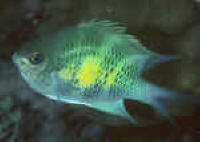
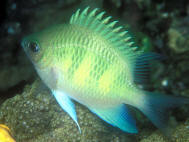
|
| Amblyglyphidodon
leucogaster (Bleeker 1847), the White- or Yellowbelly
Damselfish. Quite variable in appearance, as evidenced in
its multiple common names, the Yellow/Whitebelly Damsel may well be
two distinct species'¦ The Indo-West Pacific (Melanesia,
Micronesia, Ryukyus to the GBR) form separate from the eastern
Africa into Red Sea one. Both are beautiful and aquarium-desirable
varieties, found on reef slopes, passages and lagoons. This species
too is a generalized zooplanktivore, feeding on crustaceans
(copepods, mysids, amphipods, other crustacean larvae), fish eggs,
and some algae. Fiji specimen at right. Below, left to right: from
the Red Sea, Bunaken/Sulawesi/Indonesia, and the Maldives. |
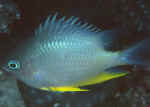
|
| Amblyglyphidodon ternatensis (Bleeker,
1853), the Ternate Damsel. Western Pacific. To four inches in
length. |
No pic
|
Genus Chromis:
| Chromis alpha Randall 1988, the
Yellow-Speckled Chromis. Western and central southern Pacific, plus
eastern Indian Ocean. To about three inches in length. A touchier
species that rarely makes its way into the hobby, mainly from Fiji.
One in Bunaken/Sulawesi/Indonesia, another in Fiji. |
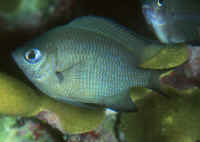
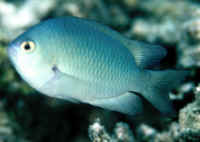
|
| Chromis amboinensis (Bleeker 1873), the
Ambon Chromis. West-central Pacific; Cocos-Keeling Islands to Samoa
and the Marshall Islands. To three inches in length. This one off
of Queensland, Australia. |
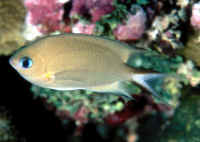
|
| Chromis analis (Cuvier 1830), Yellow
Chromis. To 17 cm. in length. Western Pacific; Japan, Australia,
Fiji. One in Fiji, another in N. Sulawesi. |
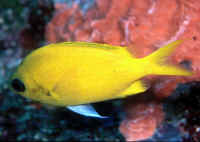 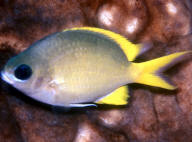
|
| Chromis atripectoralis Welander &
Schultz 1951, the Black-Axil Chromis. Very similar to the
oh-so-common Blue Chromis, C. viridis, but distinguished by a
prominent black blotch at their insertion to the pectoral fins.
Indo-Pacific but not Hawai'i. This specimen in Australian
waters. To four and a half inches in length. |
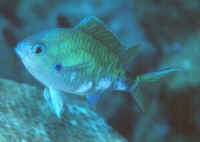
|
| Chromis caudalis Randall 1988, the Dusky
Chromis. Eastern Indian and western Pacific Oceans. To three inches
in length. Mainly imported from the Marshalls and Indonesia. A
hardy species if shipped properly and not nicked. This one in
Bunaken/Sulawesi/Indonesia. |
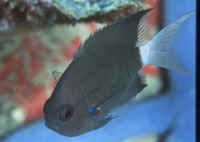
|
| Chromis dimidiata (Klunzinger 1871), the
Two-tone Chromis. Indian Ocean and Red Sea (origin of this image).
To two inches overall length. A more common offering in European
pet-fish markets. Red Sea image. |
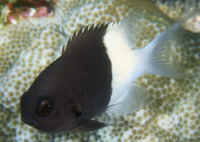
|
| Chromis margaritifer Fowler 1926, the
Bicolor Chromis. Indo-Pacific. To three and a half inches in
length. This one odd of Pulau Redang, Malaysia. |
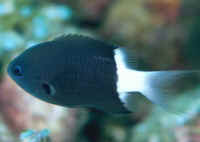
|
| Chromis retrofasciata Weber 1913, the
Blackbar Chromis. Western Pacific; Indonesia to Fiji to the Ryukyus
and New Caledonia. To two inches in length. N. Sulawesi pic. |
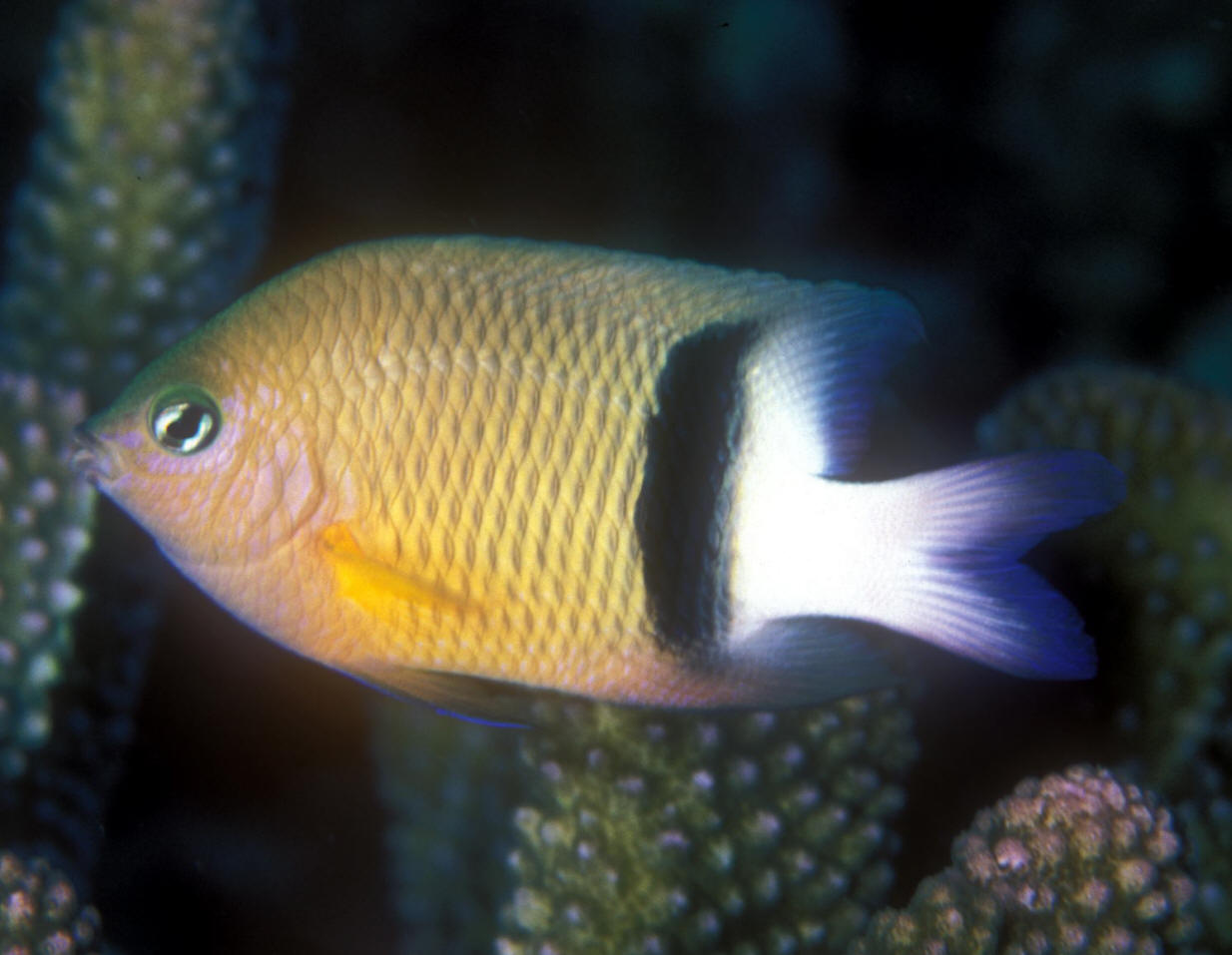
|
| Chromis viridis (Cuvier 1830), the
Blue-Green Chromis. Widespread in the Indo-Pacific and in marine
and reef aquarium usage. The darling damsel of reefkeepers. To
three inches maximum length. Formerly (and often still) identified
as Chromis cyanea. One of many in Australia, and a grouping
in Nuka Hiva, Marquesas, Polynesia. |
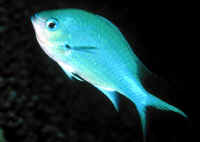 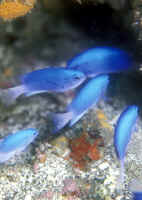
|
| Chromis weberi Fowler & Bean 1928,
Weber's Chromis. Indo-Pacific; Red Sea, East Africa to
Micronesia. To 13.5 cm. in length. Found singly or in groups at
tops of steep reef edges. Red Sea image. |
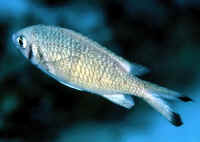
|
Genus Chrysiptera:
| Chrysiptera biocellata (Quoy & Gaimard
1825), the Twinspot Damsel, Twospot Demoiselle... Indo-west
Pacific, Africa's east coast out to Samoa. To three inches in
length. Offered in the trade from time to time. Can be feisty
toward other tankmates... should be kept with tough fishes only.
Pictured is an adult (2") in the Maldives. |
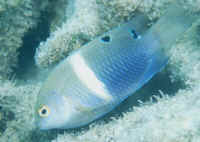
|
| Chrysiptera bleekeri (Fowler & Bean
1928), Bleeker's Damsel. Western Central Pacific; Timor, Flores
(and this report of Lombok), Indonesia and the Philippines.
To about three inches in length. Photos made off of Gili Air and N.
Sulawesi, Indonesia. |
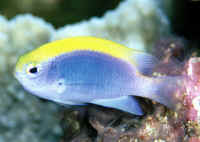
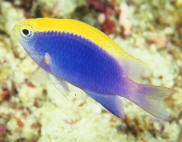
|
| Chrysiptera cyanea (Quoy & Gaimard
1825), the Blue Devil/Damsel. Likely the most commonly used member
of the Damsel family by the aquarium interest. Western Pacific over
to the bare eastern edge of the Indian Ocean. To two and a
half inches in length. Variably blue with some orange yellow on
fins. Aquarium specimens shown below. |
| Chrysiptera hemicyanea (Weber 1913), the
Azure Demoiselle. 7 cm.. Indo-West Pacific; Eastern Indian Ocean,
Indonesia. Aquarium image. |
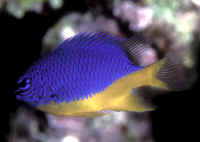
|
| Chrysiptera parasema (Fowler 1918), the
Yellow-Tail Blue Damsel. Contending for first place as "most
used member of the family of Damselfishes". From the western
Pacific. To two and a half inches. Hardy and relatively
easygoing. One in an aquarium, another in N. Sulawesi by RMF and
another aquarium shot by Hiroyuki Tanaka. |
| Chrysiptera rollandi (Whitley 1961),
Rolland's Demoiselle. Indo-Australia Archipelago. To a mere one
and three quarters inch in length. In Pulau Redang, Malaysia, and
N. Sulawesi. |
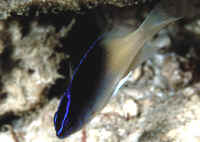
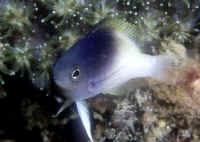
|
| Chrysiptera talboti (Allen 1975),
Talbot's Damsel. Indo-West Pacific. To about two inches maximum
length. A great little Damsel for reef aquariums. Regularly
collected for the ornamental trade in Fiji. Australian, Fiji
and N. Sulawesi images. |
| Chrysiptera unimaculata (Cuvier 1830), the
One spot Demoiselle. Indo-west Pacific, Red Sea. Highly variable in
markings, color, from east coast of Africa to Fiji. This juvenile
and sub-adult in the Maldives. To three inches overall in length.
Imported as juveniles that turn overall brownish with age. |
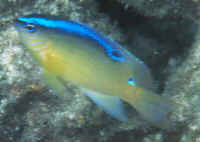
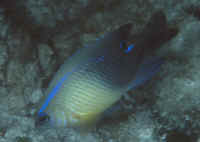
|
Genus Dascyllus:
| Dascyllus aruanus (Linnaeus
1758), the Whitetail Dascyllus to science, more commonly called the
Three-Striped Damsel to aquarists. Indo-west Pacific: Red Sea,
Africa's eastern coast to the Tuamotus in the Pacific. To four
inches. Aquarium and Red Sea photos. |
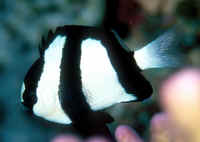 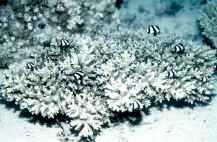
|
| Dascyllus carneus Fischer
1885, the Cloudy Damsel. Widespread in the Indian Ocean.
Occasionally offered in the aquarium trade. To two and a half
inches in length. Lives around branching corals. Adult and juv.s in
N. Sulawesi (Lembeh Strait). |
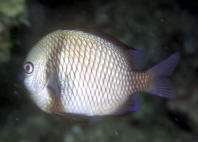 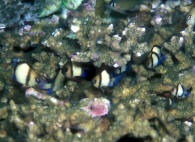
|
| Dascyllus melanurus Bleeker
1854, the Four-Stripe Damsel or Blacktail Humbug. Indo-Australian
Archipelago. To three inches overall length. Typically found about
isolated coral heads. |
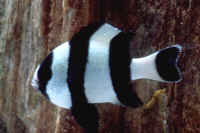
|
| Dascyllus reticulatus
(Richardson 1846), the Reticulate Dascyllus. East Indian Ocean,
west Pacific. To three and a half inches in length. A specimen in
Australia, and in S. Sulawesi. |
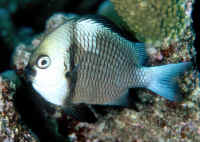 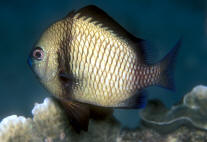
|
| Dascyllus
trimaculatus (Ruppell 1829), the Three-Spot Damsel or
Domino. Indo-west Pacific. To five and a half inches in length.
Lives on coral and rocky reefs.... and so feisty, it bites the
hands of the aquarists who feed it! Three color varieties shown
below and a group of juveniles in association with an anemone in
Mabul, Malaysia and Ras Mohamed, Egypt's Red Sea at
right. |
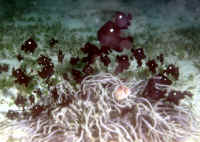
|
Genus Dischistodus:
| Dischistodus melanotus (Bleeker 1858), the
Black-Vent Damsel. Western Pacific distribution (this one in
Indonesia). To five inches overall length. |
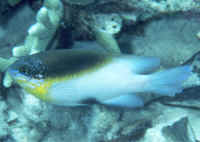
|
| Dischistodus perspicillatus (Cuvier 1830),
the White Damsel. Indo-West Pacific. To six inches in length. This
one off of Pulau Redang, Malaysia. |
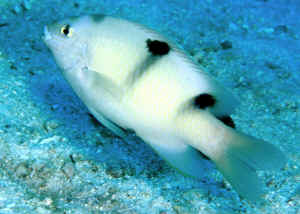
|
| Dischistodus prosopotaenia (Bleeker 1852),
the Honey-Head Damsel. Indo-West Pacific. To six inches in length.
A juvenile in Heron Island waters, GBR, Australia, an intermediate
size one and five inch adult (that bit me!) in N. Sulawesi (so I
took its picture). |
Genus Neoglyphidodon:
| Neoglyphidodon crossi Allen 1991, Cross'
Damsel. Indo-Malayan Archipelago: known only from Sulawesi and the
Molucca Islands. To four inches. Aquarium image |
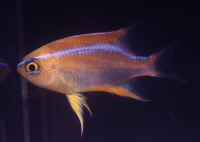
|
| Neoglyphidodon nigroris (Cuvier 1830),
Behn's Damsel. Western Pacific and eastern Indian Ocean. To
three and a half inches in length. The bright yellow and two
horizontal black band juveniles are used quite often in the trade.
Here's a juvenile off Heron Island, Australia. and subadult in
Bunaken/Sulawesi/Indonesia. |
| Neoglyphidodon oxyodon (Bleeker 1858), the
most commonly named "Jewel Damsel" in the aquarium
interest is called the Javanese Damsel to science. Indo-Australian
Archipelago. To six inches total length, and a tough customer
nearing larger size. |
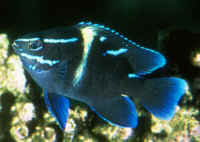
|
Genus Neopomacentrus:
Genus Plectroglyphidodon:
| Plectroglyphidodon dickii (Lienard 1839),
the Blackbar Devil. To four or so inches in length. Indo-Pacific;
East Africa to the Tuamotus. This one in Fiji. Associated with
Acropora, Pocillopora spp. corals. Feeds on filamentous algae,
benthic crustaceans, small fishes. |
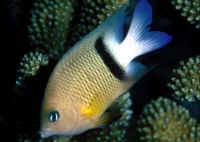
|
| Plectroglyphidodon johnstonianus (Fowler
& Ball 1924), the Johnston Island Damsel. Despite its common
name this species is found in the Indo-Pacific, eastern Africa to
Hawai'i (where this image is from). To two and a half inches
long. |
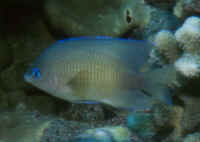
|
| Plectroglyphidodon lacrymatus (Quoy &
Gaimard 1825), the Jewel Damsel, Whitespotted Devil. Indo-west
Pacific, eastern Africa and Red Sea to the Society Islands. One in
Fiji, another in N. Sulawesi. |
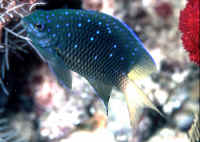 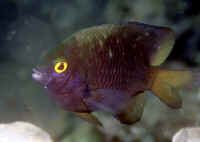
|
Genus Pomacentrus:
| Pomacentrus alleni Burgess 1981,
Allen's or Andaman Damselfish. Andaman Sea, the Similans off of
Thailand. A hardy beauty that grows to a maximum of two inches and
does well living solitarily. This one in a reef aquarium by
itself. |
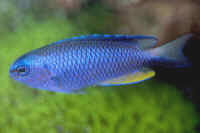
|
| Pomacentrus auriventris Allen 1991, the
Yellow-belly or Goldbelly Damsel. Indo-Malay Peninsula, Caroline
Islands. To 5.5 cm. Found near bottom, principally about rubble
slopes. N. Sulawesi pix. |
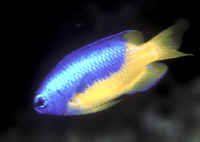 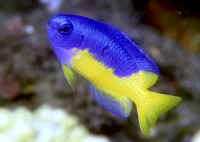
|
| Pomacentrus caeruleus Quoy & Gaimard
1825, the Caerulean Damsel. Western Indian Ocean, eastern Africa to
the Maldives. To four inches maximum. A Damselfish beauty that
deserves to be imported much more frequently. This one in the
Maldives. |
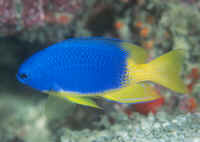
|
| Pomacentrus chrysurus Cuvier 1830, the
Whitetail Damsel. Indo-west Pacific. To about three inches in
length. A better looking individual, with a broad yellow dorsal
band and ocellus, the adults (pictured) are overall slate colored
with a white tail. Maldives image. |
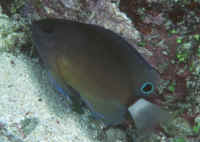
|
| Pomacentrus coelestis Jordan & Starks
1901, one of the Neon Damsels. To three and a half inches in
length. Widespread in the Indo-Pacific, and a common import. This
is a feisty damselfish species, best kept as the only Damsel type
in a tank, and allowing a good fifteen gallons plus per specimen.
An alpha male in the Cooks, one in Fiji. |
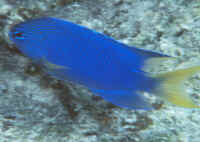 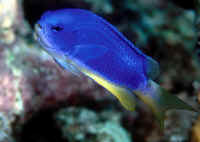
|
| Pomacentrus moluccensis (Bleeker 1853), the
Lemon Damsel. Eastern Indian and western Pacific Oceans. To two
inches in length. This little beauty is occasionally imported from
Fiji (where the first picture was taken), Tonga and Vanuatu. Second
image, Heron Island, Australia. Third, N. Sulawesi. |
| Pomacentrus nigromanus Weber 1913, the
Goldback Damsel. Western Central Pacific. To 9 cm. This one in S.
Sulawesi. |
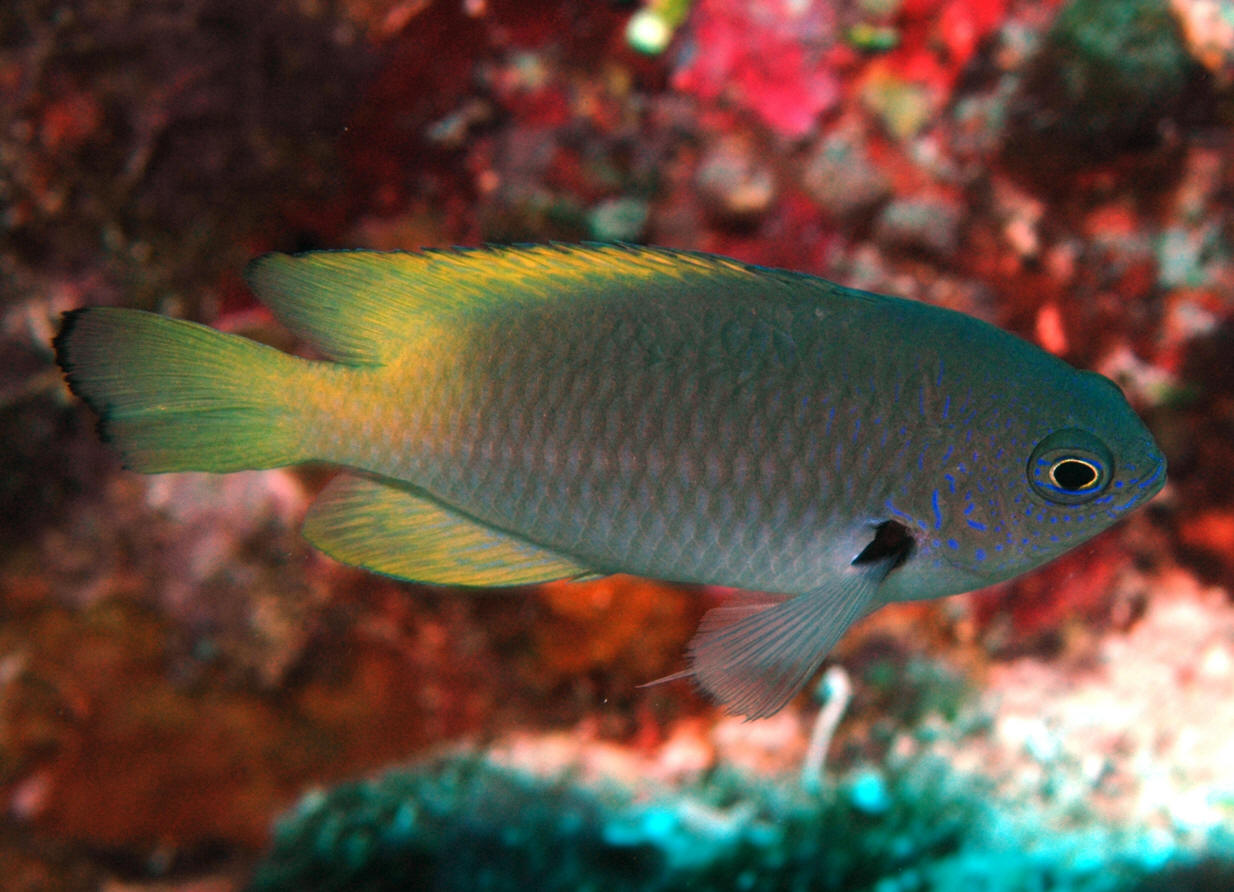
|
| Pomacentrus pavo (Bloch 1787), the Sapphire
or Peacock Damsel. Indo-Pacific. To three inches in length. A hardy
beauty for peaceful all-fish as well as reef tanks. Can be kept
singly. This one photographed in the Maldives. |
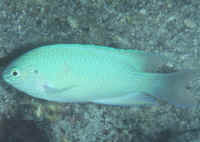
|
| Pomacentrus philippinus (Evermann &
Seale 1907), the Philippine Damsel. Western Pacific and eastern
Indian Oceans. Variable in amount of yellow coloring by vicinity.
To three inches in length. One in the Maldives where only their
tails are yellow, and another in Mabul, Malaysia. |
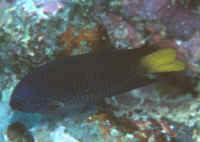 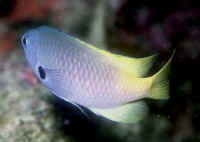
|
| Pomacentrus reidi Fowler & Bean 1928,
Reid's Damsel. Indo-Australian; Philippines, Celebes,
Australia, Solomon's. To 9 cm. Found on steep, outer reef
slopes, typically solitarily. N. Sulawesi pix. |
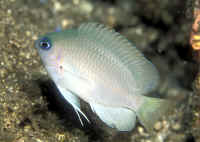 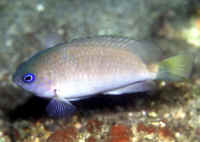
|
| Pomacentrus vaiuli Jordan & Seale 1906,
the Ocellated Damselfish. Western Pacific to Eastern Indian Ocean.
To four inches in length, and as territorial as the genus comes...
hangs out on its patch of Acroporid coral in the wild, and best
kept this way with plenty of room (at least twenty gallons to each)
in captivity. Juveniles in the Cooks and N. Sulawesi shown (bottom
one a half inch long), and one mid-age in Fiji. Color variable, some with a yellowish dorsal
region grading to blue. |
Genus Stegastes:
| Stegastes fasciolatus (Ogilby 1889), the
Pacific Gregory. Indo-west Pacific. Not a great beauty and at up to
six inches in length, a handful. But an interesting, intelligent
addition to a rougher aquarium setting. These images younger
to older individuals in Hawai'i. |
Bibliography/Further Reading:
Allen, Gerald R. 1975. Damselfishes of the South Seas.
TFH Publications, Neptune City, N.J.
Allen, Gerald R. 1976. How many sergeant majors? Marine
Aquarist 7(6):76.
Allen, Gerald R. 1991. Damselfishes of the World.
Aquarium Systems, Mentor, Ohio.
American Society of Ichthyologists and Herpetologists,
1978. The Biology of the Damselfishes a symposium held during the 56th
annual meeting of the ASIH. Rosentiel School of Mar. & Atm. Sci. U.
of Miami, 1980, 145-328.
Burgess, Warren E. 1981. Pomacentrus alleni and
Pomacentrus thiellei, two new species of Pomacentrids (Pisces:
Pomacentridae) from the Indo-Pacific. TFH 11/81.
Emmens, C.W. 1984. Damselfishes. TFH 9/84.
Fenner, Robert. 1998. The Conscientious Marine Aquarist.
Microcosm, VT. 432pp.
Fenner, Robert. 1999. The indomitable damsels- Family
Pomacentridae. TFH 1/99.
Gronell, A.M., 1984. Look-alike damsels. TFH 32(8)
48-53.
Howe, Jeffrey C. 1995. Original descriptions: Colombo
damsel Pomacentrus proteus Allen, 1991. FAMA 8/95.
|
|

